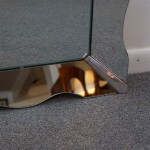How To Remove Paint From Wood Mirror Frames
Removing paint from a wooden mirror frame can seem daunting, but with the right tools and techniques, it can be accomplished effectively without damaging the underlying wood. This article outlines various methods for stripping paint from wood, allowing for the restoration of the frame's natural beauty or preparation for a new finish.
1. Chemical Strippers
Chemical paint strippers are a powerful option for removing multiple layers of paint, particularly thick or stubborn coatings. They are available in various formulations, including liquid, gel, and paste. Gel or paste strippers are often preferred for vertical surfaces like mirror frames as they cling better and minimize dripping.
Before applying a chemical stripper, ensure adequate ventilation in the work area and wear appropriate safety gear, including gloves, eye protection, and a respirator. Following the manufacturer's instructions, apply a thick layer of the stripper to the painted surface using a brush or scraper. Allow the stripper to dwell for the recommended time, which will vary depending on the product and the number of paint layers. The paint will begin to bubble and lift, indicating it's ready for removal.
Once the paint has softened, carefully scrape it away using a plastic or metal scraper. Avoid using excessive force, which could damage the wood. For intricate details or carved areas, a stiff-bristled brush or a toothbrush can be helpful. After removing the bulk of the paint, neutralize the stripper according to the manufacturer's instructions. This typically involves wiping the surface with a specific solvent or a mixture of water and vinegar.
2. Heat Guns
Heat guns use high temperatures to soften paint, making it easier to scrape away. They are particularly effective for removing thicker layers of oil-based paint. When using a heat gun, hold it several inches from the surface and move it continuously to prevent scorching the wood. As the paint softens, use a scraper to lift and remove it.
Caution is crucial when using a heat gun. Excessive heat can scorch the wood or even ignite flammable materials. Always test the heat gun on an inconspicuous area of the frame first to determine the appropriate temperature and technique. Keep a fire extinguisher nearby and work in a well-ventilated area.
Heat guns are not recommended for removing paint from delicate or antique frames, as the high heat can damage the wood or existing finish. They are also less effective on water-based paints.
3. Sanding
Sanding can be used to remove paint, but it's a more labor-intensive process and can remove some of the wood along with the paint. It's best suited for smaller areas or for removing residual paint after using a chemical stripper or heat gun. Start with a coarser grit sandpaper (e.g., 80-grit) and gradually move to finer grits (e.g., 150-220 grit) to smooth the surface. Always sand in the direction of the wood grain to minimize scratches.
Electric sanders can speed up the process, but they require careful control to avoid gouging the wood. Orbital sanders are generally a good choice for removing paint from flat surfaces, while detail sanders are better suited for intricate areas. For delicate frames, hand sanding is often the safest option.
4. Natural Paint Removers
For those seeking a more environmentally friendly approach, natural paint removers are available. These products typically use plant-based ingredients like citrus solvents to soften paint. While they may be less potent than chemical strippers, they are a safer alternative, particularly for indoor use.
Application methods for natural paint removers are similar to those used for chemical strippers. Apply a thick layer, allow it to dwell for the recommended time, and then scrape away the softened paint. Multiple applications may be necessary for thicker paint layers.
5. Choosing the Right Method
The best method for removing paint from a wood mirror frame depends on several factors, including the type of paint, the number of layers, the intricacy of the frame, and personal preference. Chemical strippers are effective for removing thick layers of paint but require careful handling due to their toxicity. Heat guns are suitable for oil-based paints but pose a risk of scorching the wood. Sanding is a versatile option but can be time-consuming and may remove some of the wood. Natural paint removers offer a safer alternative but may require multiple applications.
Before starting the paint removal process, test the chosen method on an inconspicuous area of the frame to assess its effectiveness and ensure it doesn't damage the wood. Once the paint has been successfully removed, the frame can be sanded smooth, stained, or painted as desired.

How To Remove Paint From Wood Finishes Direct

How To Remove Stain Off Wood Hallstrom Home

How To Remove Paint On A Mirror Doityourself Com

The Ultimate Guide On Diy Antique Mirrors So Much Better With Age

How To Remove Veneer From Wood H2obungalow

How To Remove Stain Off Wood Hallstrom Home

How To Refinish An Antique Mirror With A Dark Stained Frame Celebrated Nest

How To Remove Veneer From Wood H2obungalow

How To Paint A Mirror Frame The Easy Way By Just Woods

How Do You Distress A Gold Mirror Frame Hometalk








